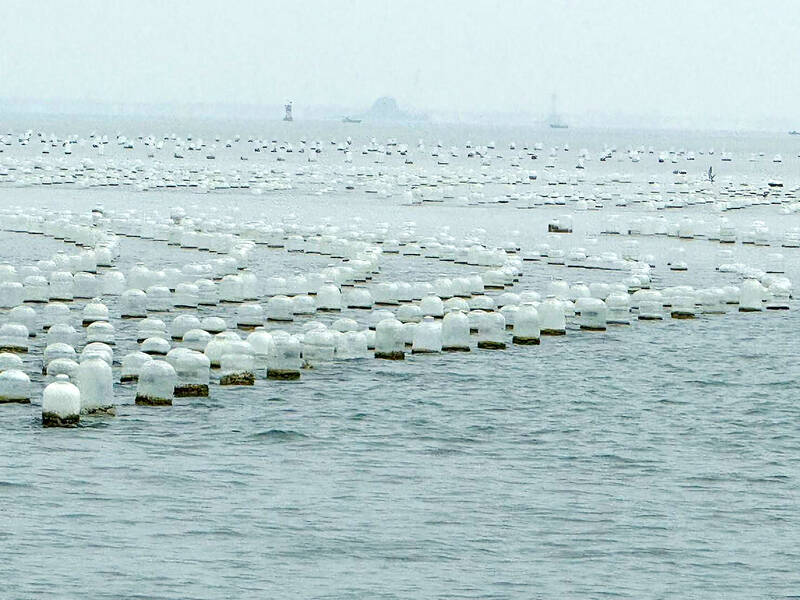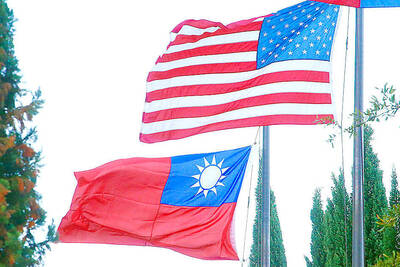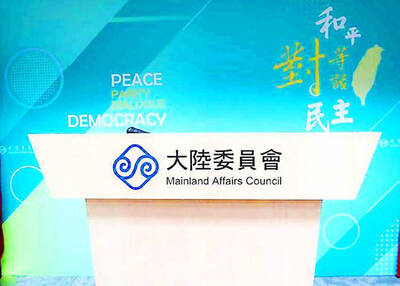The government is to remove illegal oyster racks in waters between Kinmen County and Xiamen, China, the Executive Yuan said yesterday, adding that no Chinese fishers would be allowed to enter Taiwan’s territorial waters to remove them.
At one point, nearly 200 hectares of illegal oyster racks were in the area, which has generated national security concerns as some Chinese fishers cross into to Taiwan’s territorial waters to harvest oysters.
The oyster racks have been erected amid China’s escalating “gray zone” harassment of Taiwan.

Photo courtesy of the Kinmen County Government
The Kinmen County Government said that Chinese fishers should be allowed to enter Taiwanese waters to remove the racks, with the Coast Guard Administration (CGA) overseeing the process.
The county said it does not have the funding, vessels or staffing to remove them, and conflicts could erupt during the process.
However, Minister Without Portfolio Lin Ming-hsin (林明昕) said the Cabinet decided the government would handle the matter.
“We will work with the Kinmen County Government to remove the racks, because the interests of Kinmen County residents who operate oyster farms legally are also at stake,” Lin said.
The Executive Yuan would also discuss ways to prevent illegal oyster racks from reappearing, he said.
Residents in Kinmen and Lienchiang (Matsu) counties can continue to legally operate oyster farms, so long as they are not providing cover for illegal Chinese operations, he said.
China has been conducting “gray zone” activities and challenging Taiwanese law enforcement personnel with government-run and private vessels, executive Yuan spokeswoman Michelle Lee (李慧芝) said.
The coast guard would continue to deploy vessels to patrol the waters near the outlying islands, while the Executive Yuan would assist the Kinmen County Government in managing oyster farms by registering fishers in the county, she said.
Since 2008, the government has seized eight boats and detained 18 people who illegally hired Chinese to run oyster farms, CGA data showed.
Fourteen people on six of the vessels have been sentenced to prison terms or fines by the judiciary. Four people operating on the other two boats are being investigated by prosecutors.
Meanwhile, NT$1.25 million (US$42,199) in fines have been imposed, and five Chinese-flagged oyster-harvesting boats, 13,914kg of oysters and 20,000 oyster seedlings have been confiscated, the data showed.
Chinese vessels entering Taiwan’s waters to harvest oysters is a national security issue, Democratic Progressive Party Legislator Lai Jui-long (賴瑞隆) said on Wednesday.
“The government must more actively counter gray zone harassment, whether it is through fishing boats or rubber boats. National security officials need to tackle the national security issue forcefully, while the Kinmen County Government needs to work with the central government in enforcing the law,” Lai said.
Additional reporting by Wu Cheng-ting

Taiwan is projected to lose a working-age population of about 6.67 million people in two waves of retirement in the coming years, as the nation confronts accelerating demographic decline and a shortage of younger workers to take their place, the Ministry of the Interior said. Taiwan experienced its largest baby boom between 1958 and 1966, when the population grew by 3.78 million, followed by a second surge of 2.89 million between 1976 and 1982, ministry data showed. In 2023, the first of those baby boom generations — those born in the late 1950s and early 1960s — began to enter retirement, triggering

One of two tropical depressions that formed off Taiwan yesterday morning could turn into a moderate typhoon by the weekend, the Central Weather Administration (CWA) said yesterday. Tropical Depression No. 21 formed at 8am about 1,850km off the southeast coast, CWA forecaster Lee Meng-hsuan (李孟軒) said. The weather system is expected to move northwest as it builds momentum, possibly intensifying this weekend into a typhoon, which would be called Mitag, Lee said. The radius of the storm is expected to reach almost 200km, she said. It is forecast to approach the southeast of Taiwan on Monday next week and pass through the Bashi Channel

NO CHANGE: The TRA makes clear that the US does not consider the status of Taiwan to have been determined by WWII-era documents, a former AIT deputy director said The American Institute in Taiwan’s (AIT) comments that World War-II era documents do not determine Taiwan’s political status accurately conveyed the US’ stance, the US Department of State said. An AIT spokesperson on Saturday said that a Chinese official mischaracterized World War II-era documents as stating that Taiwan was ceded to the China. The remarks from the US’ de facto embassy in Taiwan drew criticism from the Ma Ying-jeou Foundation, whose director said the comments put Taiwan in danger. The Chinese-language United Daily News yesterday reported that a US State Department spokesperson confirmed the AIT’s position. They added that the US would continue to

The number of Chinese spouses applying for dependent residency as well as long-term residency in Taiwan has decreased, the Mainland Affairs Council said yesterday, adding that the reduction of Chinese spouses staying or living in Taiwan is only one facet reflecting the general decrease in the number of people willing to get married in Taiwan. The number of Chinese spouses applying for dependent residency last year was 7,123, down by 2,931, or 29.15 percent, from the previous year. The same census showed that the number of Chinese spouses applying for long-term residency and receiving approval last year stood at 2,973, down 1,520,